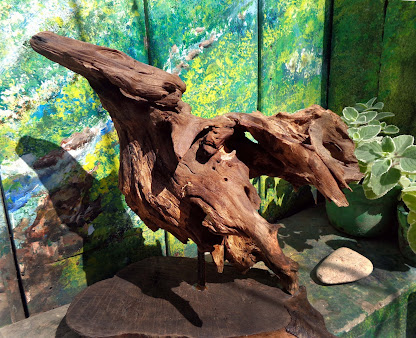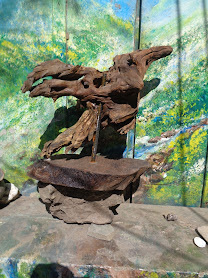Driftwood Art
Philippine Eagle -
Descendant of the Archaeopteryx
On display at the Living with Nature Center, San Vicente, Ilocos Sur
"All available evidence indicates unequivocally that Archaeopteryx evolved from a small coelurosaurian dinosaur and that modern birds are surviving dinosaurian descendants. Stated simply, avian phylogeny was: Pseudosuchia Coelurosauria Archaeopteryx higher birds." - John H. Ostrom, Archaeopteryx and the origin of birds, Biological Journal of the Linnean Society,
Dr Abe V Rotor
Driftwood Figurine of the Archaeopteryx in different views
Archaeopteryx, sometimes referred to by its German name, "Urvogel" is a genus of bird-like dinosaurs. The name derives from the ancient Greek ἀρχαῖος, meaning "ancient", and πτέρυξ, meaning "feather" or "wing". It lived 150.8 million years ago - 125.45 million years ago. Archaeopteryx had teeth and a long bony tail, just like other dinos in the theropod family, including Tyrannosaurus rex and Allosaurus. But it had characteristics of modern birds, too, like feathers and a wishbone, or furcula, which aids modern birds' flight. It also had wings—but with claws on them. Photo below, left.
------------------
AnnexArchaeopteryx and the origin of birds
JOHN H. OSTROM
Biological Journal of the Linnean Society, Volume 8, Issue 2, June 1976, Pages 91–182, https://doi.org/10.1111/j.1095-8312.1976.tb00244.x
Published: 14 January 2008 Article history
The question of the origin of birds can be equated with the origin of Archaeopteryx, the oldest known bird. Analysis of the five presently known skeletal specimens of Archaeopteryx. and comparison with the skeletal anatomy of the several reptilian groups that have been proposed as possible ancestors of birds (Ornithopoda, Theropoda, Hseudosuchla and Sphenosuchidac), confirm the conclusions (long rejected by most subsequent workers) of Heilmann (1926), Lowe (1935, 1944) and Holmgren (1955), namely, that the skeletal anatomy of Archaeopteryx is extraordinarily similar to that of contemporaneous and succeeding coelurosaurian dinosaurs. Rejection of these similarities as adaptive structures only (parallel or convergent similarities), and therefore of no phylogenetic importance, is here considered invalid. Heilmann was the first to identify the only evidence that has been cited so far for dismissing coelurosaurian-avian ancestral–descendant relationships, the supposed absence of clavicles in all theropods, and on that basis suggested a common Archaeopteryx–dinosaur ancestry among pseudosuchian reptiles. That evidence is negative and thus inconclusive, and is now known to be false.
With the exception of fused clavicles and unique ischial morphology, virtually every skeletal feature of Archaeopteryx is known in several contemporaneous or near-contemporary coelurosaurian dinosaurs and many of these conditions are unrelated, specialized features (the detailed morphology of the manus, metacarpus, carpus, humerus, scapulocoracoid, pes, metatarsus, tarsus, femur, pubis, ilium, skull and mandibles). The presence of so many derived characters in common clearly establishes that the closest ancestral affinities ot Archaeopteryx are with coelurosaurian theropods. There is no contrary evidence and any other explanation is illogical.
All available evidence indicates unequivocally that Archaeopteryx evolved from a small coelurosaurian dinosaur and that modern birds are surviving dinosaurian descendants. Stated simply, avian phylogeny was: Pseudosuchia Coelurosauria Archaeopteryx higher birds. ~ (Acknowledgement with gratitude to John H. Ostrom Biological Journal of the Linnean Society)














No comments:
Post a Comment